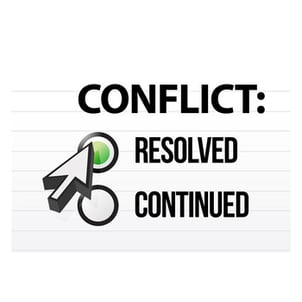Why Is There No Conflict on My Team?
During the past several months, I have been the lead consultant on a major engagement to develop  and provide leadership skills to middle-level managers dealing with the realities of the VUCA world of 2016 and beyond. The learning journey has been instructionally designed to include eLearning pre-work, live classroom discussion, business leadership simulations, and application back to the real world. We are delivering the engagement in groups of about 50 participants at a time and for each group we tailor the entire journey to their specific needs and current business challenges. This past week, one of the participants shared a current challenge that was fascinating to explore from a business leadership perspective.
and provide leadership skills to middle-level managers dealing with the realities of the VUCA world of 2016 and beyond. The learning journey has been instructionally designed to include eLearning pre-work, live classroom discussion, business leadership simulations, and application back to the real world. We are delivering the engagement in groups of about 50 participants at a time and for each group we tailor the entire journey to their specific needs and current business challenges. This past week, one of the participants shared a current challenge that was fascinating to explore from a business leadership perspective.
We had been discussing models of coaching and feedback in team conflict situations when she asked the following question:
“Should I be concerned that there is no conflict on my team? Everyone gets along so well…”
There was a murmur or two in the group and several other managers also chimed in that they also have teams with little to no conflict. After a brief discussion – and input from some of the participants who shared they have a lot of conflict – we concluded that conflict, when managed well, is a good thing because it helps drive innovation, pushes people to think outside of the box, motivates them, energizes them, and can provide a sense of ownership.
One of the most important tools of leadership is understanding different styles of people in the leadership ecosystem including peers, direct reports, and supervisors. Based on research, analysis, and years of observations working with large organizations, I offer five different conflict personality styles to help with understanding and managing conflict - or a lack of conflict - and what leaders should do.
The Avoiding Style
In the case of the participant who asked the question, it was clear that she had a team of people who avoided conflict. People who avoid conflict hope the issue goes away without a confrontation. Unfortunately, this can be counterproductive and as a leader, you need to identify behaviors of avoidance and bring issues into the conversation, strategy, and process of getting the job done.
The Accepting Style
The accepting style is a person who goes along with the flow and doesn’t challenge or ask the tough questions. They are very accommodating and wants everyone to get along. Again, this unfortunately can be counterproductive. As a leader, you need to identify behaviors where people always accept things and don’t challenge the status quo or seek new ideas and new solutions.
The Bargaining Style
The bargaining style is a person who is always bargaining, trading, and wheeling and dealing. “I will let you use Tom if you let me have Sally for the next project” is something you would hear from this style. This is a style where people on your team feel equal and free to solve problems. As a leader, you need to identify behaviors where people are always bargaining and compromising as a lack of conflict could lead to water-downed solutions.
The Cooperating Style
The cooperating style is a person who finds creative solutions that are acceptable to everyone. As a leader, this is a very desirable behavior to have on your team because it will embrace conflict and find solutions. The one thing you need to keep your eye on is that the cooperating process can often take a long time because it is inclusive and encourages different ideas and perspectives.
The Challenging Style
The challenging style is the most difficult because it is a personality that believes in an “I Win-You Lose” approach. They are highly competitive and create situations where it is either their way or no way. Challenging styles are very confrontational and usually don’t mix well with any of the other four styles I mentioned. The only time the challenging style is successful is when there is a stressful situation like a deadline or a competitive attack. As a leader, you need identify anyone on your team who has this type of challenging style and coach them to understand their strengths and how it also can be a detriment.
In summary, conflict is good and it is important. Too much conflict can be detrimental and not enough conflict can cause complacency. Leaders – especially middle-level leaders – must pay careful attention to the Conflict Style of people they work with and manage them to find the right balance to be productive and to achieve goals and objectives.




